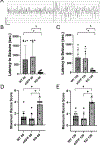Loss of Slc35a2 alters development of the mouse cerebral cortex
- PMID: 38909838
- PMCID: PMC12140808
- DOI: 10.1016/j.neulet.2024.137881
Loss of Slc35a2 alters development of the mouse cerebral cortex
Abstract
Brain somatic variants in SLC35A2, an intracellular UDP-galactose transporter, are commonly identified mutations associated with drug-resistant neocortical epilepsy and developmental brain malformations, including focal cortical dysplasia type I and mild malformation of cortical development with oligodendroglial hyperplasia in epilepsy (MOGHE). However, the causal effects of altered SLC35A2 function on cortical development remain untested. We hypothesized that focal Slc35a2 knockout (KO) or knockdown (KD) in the developing mouse cortex would disrupt cortical development and change network excitability. Through two independent studies, we used in utero electroporation (IUE) to introduce CRISPR/Cas9/targeted guide RNAs or short-hairpin RNAs into the embryonic mouse brain at day 14.5-15.5 to achieve Slc35a2 KO or KD, respectively, from neural precursor cells. Slc35a2 KO or KD caused disrupted radial migration of electroporated neurons evidenced by heterotopic cells located in lower cortical layers and in the sub-cortical white matter. Slc35a2 KO in neurons did not induce changes in oligodendrocyte number, importantly suggesting that the oligodendroglial hyperplasia observed in MOGHE originates from distinct cell autonomous effects of Slc35a2 mutations. Adult KO mice were implanted with EEG electrodes for 72-hour continuous recording. Spontaneous seizures were not observed in focal Slc35a2 KO mice, but there was reduced seizure threshold following pentylenetetrazol injection. Here we demonstrate that focal Slc35a2 KO or KD in vivo disrupts corticogenesis through altered neuronal migration and that KO leads to reduced seizure threshold. Together these results demonstrate a direct causal role for SLC35A2 in cortical development.
Keywords: CRISPR; Cerebral cortex; Cortical dysplasia; Glycosylation; Short-hairpin RNA.
Copyright © 2024 The Author(s). Published by Elsevier B.V. All rights reserved.
Conflict of interest statement
Declaration of competing interest The authors declare that they have no known competing financial interests or personal relationships that could have appeared to influence the work reported in this paper.
Figures



Update of
-
Loss of Slc35a2 alters development of the mouse cerebral cortex.bioRxiv [Preprint]. 2023 Nov 30:2023.11.29.569243. doi: 10.1101/2023.11.29.569243. bioRxiv. 2023. Update in: Neurosci Lett. 2024 Jul 27;836:137881. doi: 10.1016/j.neulet.2024.137881. PMID: 38077069 Free PMC article. Updated. Preprint.
References
-
- Blumcke I, Aronica E, Miyata H, et al., International recommendation for a comprehensive neuropathologic workup of epilepsy surgery brain tissue: A consensus Task Force report from the ILAE Commission on Diagnostic Methods, Epilepsia 57 (3) (2016. Mar) 348–358. - PubMed
-
- Bedrosian TA, Miller KE, Grischow OE, et al., Detection of brain somatic variation in epilepsy-associated developmental lesions, Epilepsia 63 (8) (2022. Aug) 1981–1997. - PubMed
MeSH terms
Substances
Grants and funding
LinkOut - more resources
Full Text Sources
Molecular Biology Databases
Research Materials

